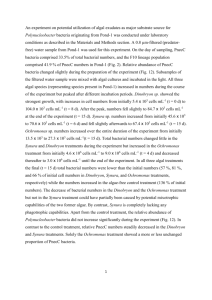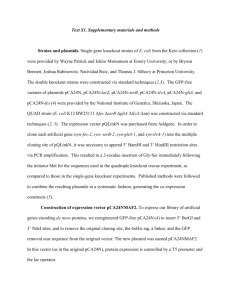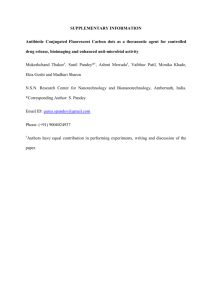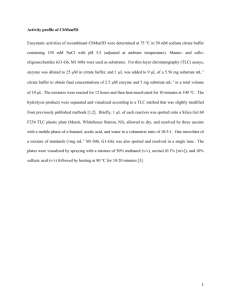jESE_Vol3_No2_p81
advertisement
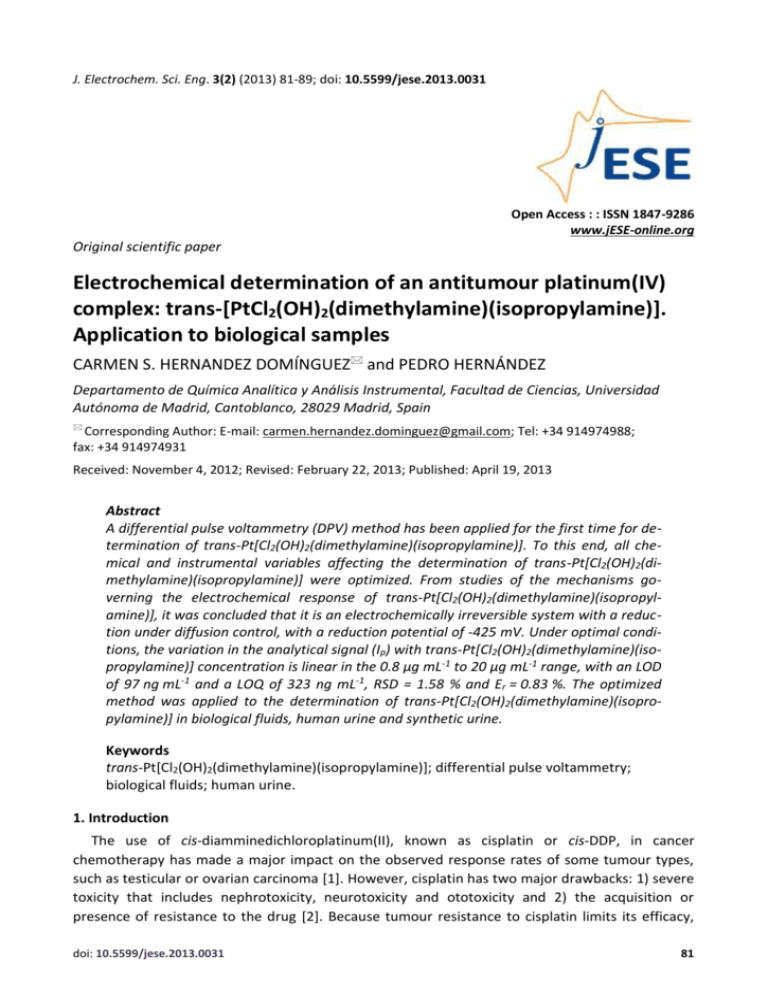
J. Electrochem. Sci. Eng. 3(2) (2013) 81-89; doi: 10.5599/jese.2013.0031 Open Access : : ISSN 1847-9286 www.jESE-online.org Original scientific paper Electrochemical determination of an antitumour platinum(IV) complex: trans-[PtCl2(OH)2(dimethylamine)(isopropylamine)]. Application to biological samples CARMEN S. HERNANDEZ DOMÍNGUEZ and PEDRO HERNÁNDEZ Departamento de Química Analítica y Análisis Instrumental, Facultad de Ciencias, Universidad Autónoma de Madrid, Cantoblanco, 28029 Madrid, Spain Corresponding Author: E-mail: carmen.hernandez.dominguez@gmail.com; Tel: +34 914974988; fax: +34 914974931 Received: November 4, 2012; Revised: February 22, 2013; Published: April 19, 2013 Abstract A differential pulse voltammetry (DPV) method has been applied for the first time for determination of trans-Pt[Cl2(OH)2(dimethylamine)(isopropylamine)]. To this end, all chemical and instrumental variables affecting the determination of trans-Pt[Cl2(OH)2(dimethylamine)(isopropylamine)] were optimized. From studies of the mechanisms governing the electrochemical response of trans-Pt[Cl2(OH)2(dimethylamine)(isopropylamine)], it was concluded that it is an electrochemically irreversible system with a reduction under diffusion control, with a reduction potential of -425 mV. Under optimal conditions, the variation in the analytical signal (Ip) with trans-Pt[Cl2(OH)2(dimethylamine)(isopropylamine)] concentration is linear in the 0.8 µg mL-1 to 20 µg mL-1 range, with an LOD of 97 ng mL-1 and a LOQ of 323 ng mL-1, RSD = 1.58 % and Er = 0.83 %. The optimized method was applied to the determination of trans-Pt[Cl2(OH)2(dimethylamine)(isopropylamine)] in biological fluids, human urine and synthetic urine. Keywords trans-Pt[Cl2(OH)2(dimethylamine)(isopropylamine)]; differential pulse voltammetry; biological fluids; human urine. 1. Introduction The use of cis-diamminedichloroplatinum(II), known as cisplatin or cis-DDP, in cancer chemotherapy has made a major impact on the observed response rates of some tumour types, such as testicular or ovarian carcinoma [1]. However, cisplatin has two major drawbacks: 1) severe toxicity that includes nephrotoxicity, neurotoxicity and ototoxicity and 2) the acquisition or presence of resistance to the drug [2]. Because tumour resistance to cisplatin limits its efficacy, doi: 10.5599/jese.2013.0031 81 J. Electrochem. Sci. Eng. 3(2) (2013) 81-89 ANTITUMOUR Pt(IV) COMPLEX: APPLICATION TO BIOLOGICAL SAMPLES there is an urgent need to discover new platinum complexes capable of overcoming cisplatin resistance. Figure 1. Structure and molecular weight of the platinum complex, transPt[Cl2(OH)2(dimethylamine)(isopropylamine)] (compound 1), used in this article Because enhanced removal of cisplatin-DNA adducts has been reported as one of the main causes of cell resistance to cisplatin, there is general consensus that this particular resistance mechanism may be circumvented by platinum complexes that bind to DNA by a different mechanism than cisplatin [3,4]. One platinum compound that possesses DNA-binding properties distinct from those of cisplatin is its trans isomer transplatin, trans-diamminedichloroplatinum(II), or trans-DDP (Fig. 1). In fact, it has been found that cis-DDP mainly forms 1,2 intrastrand crosslinks on DNA, whereas the main adducts of trans-DDP are 1,3 intrastrand cross-links [2]. Unfortunately, early structure-activity relationship studies showed that trans-DDP and other transPt complexes were inactive as antitumour drugs [5]. However, in 1989, Farrell et al. [6] reported the first cytostatic trans-Pt(II) complexes. In recent years, several classes of biologically active trans-platinum complexes have been reported [7]. Among these unusual classes of platinum drugs, it has recently been found that trans-Pt(II)Cl2 complexed with an asymmetric set of aliphatic amines is able to circumvent cisplatin resistance. It is known that resistance to cisplatin is multifactorial and includes three main mechanisms: decreased cellular accumulation of cisplatin, increased cytoplasmatic detoxification (through increased cytoplasmic levels of glutathione and metallothioneins), and increased DNA repair/tolerance of platinum-DNA adducts[8]. It has also been postulated that alterations in the apoptotic cell death pathway may constitute a fourth mechanism of cisplatin resistance[9]. The group of Carmen Navarro-Ranninger [10] has reported that the trans-platinum(II) complex with mixed aliphatic amines, trans-Pt[Cl2(OH)2(dimethylamine)(isopropylamine)] (Fig.1) circumvents cisplatin resistance in cells that overexpress oncogenes. In addition, compound 1 is also able to circumvent resistance to cisplatin in A2780cisR ovarian tumour cells, which exhibit resistance through a combination of the three mechanisms mentioned above [11]. Moreover, they observed that circumvention of cisplatin resistance by compound 1 is associated with a higher level of apoptosis induction relative to cis-DDP [12,13]. Also of interest was the observation that in A2780cisR cells there is a correlation between the DNA interstrand cross-linking efficiency of compound 1 and its ability to induce apoptosis [13]. On these grounds, Navarro-Ranninger et al. [10] reported the cytotoxic activity of the transPt[Cl2(OH)2(Dimethylamine)(isopropylamine)] (TPt complex) (Fig. 1) in pairs of cisplatin-sensitive and-resistant human ovarian tumour cell lines. The resistant cell lines showed acquired resistance to cisplatin and were selected with regard to the three major mechanisms of resistance to the drug. In addition, these cell lines have been used previously to identify novel platinum complexes capable of circumventing cisplatin resistance [14-16]. Because cellular and molecular pharmacology studies are essential to understanding the relationships between structure and 82 C. S. H. Domínguez et al. J. Electrochem. Sci. Eng. 3(2) (2013) 81-89 anticancer properties, Navarro-Ranninger et al. [10] have compared the cellular accumulation, DNA binding, interstrand cross-linking efficiency, apoptosis induction, and binding to serum albumin and plasma proteins of the trans-Pt(IV) complex (compound 1) with that of its corresponding trans-Pt(II) analog. Finally, the in vivo antitumour activity of compound 1 has been evaluated in mice bearing tumour xenografts. In this article, a new electrochemical method to determine TPt complex in biological fluids is developed. This paper makes a study of the electrochemical behaviour of this compound by differential pulse voltammetry (DPV) aimed at obtaining the optimal conditions for its determination in biological fluids and establishing its formation constants. The analysis of biological fluids presents a special relevance because small changes in the concentration of its components are thought to be correlated with several neurological or metabolic disorders [14]. 2. Experimental Reagents: TPt complex [10] was provided by Carmen Navarro-Ranninger. The purity of the analyte was 98 %. This high purity is because the complex of platinum(IV) was a synthetic product, provided by the group of Navarro-Ranninger Triple distilled mercury was used as working electrode. Buffer solutions prepared with acetic acid, phosphoric acid and borate were adjusted to the desired pH values with sodium hydroxide. Unless otherwise stated, all other reagents were of analytical grade and were used as received. Ultrapure water, obtained from Millipore MilliQ System, was used in the preparation of buffers and solutions and to clean the working electrode of possible substances adsorbed on the gold electrode surface. All solutions were prepared just prior to use, preserved at 4 °C and protected from light. Apparatus: Electrochemical measurements were performed using a Bioanalytical System (BAS) Epsilon Mercury Stand workstation, an Ag/AgCl/KCl 3M reference electrode, and a platinum wire as counter electrode. For pH adjustment, a pH-meter Methrom C831 was employed as well as a circulation ultrathermostat Frigiterm-10 (P-Selecta, Spain) to control the temperature. Procedure: TPt complex stock solution (500 µg mL-1) was prepared with ultrapure water and stored at 4±1 C preserved in aluminium foil covered bottles to avoid photodegradation. Prior to analysis, sample bottles were allowed to equilibrate to room temperature (RT). Sample preparation: The TPt complex dissolved readily and was further diluted to desired concentrations using 0.5 M acetate buffer solution. The samples used for the implementation of the method described above included a synthetic urine sample prepared in the laboratory and a sample of real human urine. The composition of the synthetic urine is presented in Table 1 [17]. Table 1. Synthetic urine composition NaCl c 5.08 g L KCl -1 2.86 g L CaCO3 -1 0.31 g L MgCl2.6H2O -1 0.42 g L -1 H2SO4 (98 %) 0.67 mL L -1 HCl (conc) 8.7 mL L -1 NH4H2PO4 3.09 g L-1 Processing of the human urine sample consisted of: 1) doping of the sample with an aliquot of TPt complex (10 µg mL-1). This value was chosen because, at this time, there are no published references devoted to the use of these compounds in humans; doi: 10.5599/jese.2013.0031 83 J. Electrochem. Sci. Eng. 3(2) (2013) 81-89 ANTITUMOUR Pt(IV) COMPLEX: APPLICATION TO BIOLOGICAL SAMPLES 2) protein precipitation with 0.1 M HClO4-; 3) digestion of the precipitate for a weekend (48 hours); 4) filtering of the sample. The filters used in the development of this process were cellulose membrane filters with a pore size of 0.45 m and 5) adjust the pH of the sample to the appropriate value. 3. Results and discussion The electrochemical study of the TPt complex was performed by DPV and square wave voltammetry in order to determine the best conditions for its analysis. 3. 1. Influence of pH and ionic strength. In order to select the optimum pH, a pH range between pH 2 and pH 12 was employed. The buffers used were phosphate buffer for pH 2, 3, 6, 7, 8, 10, 11 and 12; acetic acid buffer for pH 4 and 5; and borate buffer for pH 9. The concentration of all the buffers was 0.5 M. In Figure 2 the variation in peak intensity with respect to pH (Fig. 2a) and the variation in peak potential versus pH (Fig. 2b) are represented. This figure shows that the greatest intensity was reached at pH 4 (Fig. 2a). By representing the variation in peak potential with respect to pH (Fig 2b) three straight segments with clear variations in slope are apparent, indicating that the compound under study has two dissociation constants, which correspond to the values of K1 = 10-4.2, K2 = 10-7.7. This fact can be corroborated by observing the slopes in the Ep vs. pH graph (Fig. 2b) Figure 2. a) Variation in DPV peak intensity at different pH values. b) Variation in peak potentials. Dissociation constants were calculated from the variations in the slopes. Measurement conditions: ionic strength = 0.05 M; TPt complex concentration = 5 μg mL-1; pulse amplitude = 50 mV; scan rate = 10 mV s-1 Ep = -2pH - 426; r2 = 1 (1) Ep = -35.2 pH - 287.4; r2 = 0.995 (2) Ep = -211.5 pH + 1072.5; r2 = 0.992 (3) From the standpoint of electrochemistry, pH 4 was chosen for further study because it is the value that provided the greater intensity. The ionic strength necessary to achieve the greatest possible sensitivity in the electrochemical reaction was also studied. For this study we used solutions of acetic acid-acetate buffer (pH 4) in the concentration range between 5×10-2 and 2.0 M, and reached a maximum intensity at 5x10-2 M. This concentration was used for further studies. 84 C. S. H. Domínguez et al. J. Electrochem. Sci. Eng. 3(2) (2013) 81-89 3. 2. Instrumental variables Once the study of the chemical variables was completed, we proceeded to the optimization of instrumental variables, both by DPV and square wave voltammetry (SWV). In both techniques the values of pH 4 and ionic strength 5×10-2 M, determined above, and the analyte concentration of 10 μg mL-1 were kept constant. 3. 2. 1. Influence of pulse amplitude By changing this variable using differential pulse voltammetry, it appeared that the peak current increased linearly according to the equation: i = 0.0015 ∆E +0.0003 (4) using a scan rate of 10 mV s-1 throughout the study. However, at the same time, the width of the half peak increased, so it was necessary to compromise between sensitivity and selectivity. This occurred at a value of pulse amplitude 50 mV. The peak potential was modified according to the equation: Ep = 0.4338 ∆E - 466.88 (5) To calculate the number of electrons exchanged during the reduction a DC voltammetry was carried out, and compared with the findings obtained with DPV (Figure 3). Figure 3. Comparison of DC and DP polarograms. Measurement conditions: pH 4; ionic strength = 0.05 M; TPt complex concentration = 5 μg mL-1; scan rate = 10 mV s-1 The number of electrons exchanged was found to be two using the following equation [18]: Ep = E1/2 ± ∆E/ne (6) where Ep is the peak potential calculated at pH 4 in DPV, E1/2 is the potential calculated from DC voltammetry and ΔE is the pulse applied, at a peak potential of -426 mV and -409 mV half-wave. Therefore, the reduction process can be written as: Pt(IV) + 2e- ⇔ Pt(II) (7) The square-wave behaviour is similar to that observed with DPV, the peak current increasing linearly with pulse amplitude according to the equation: I = 0.0035 ∆E + 0.32 doi: 10.5599/jese.2013.0031 (8) 85 J. Electrochem. Sci. Eng. 3(2) (2013) 81-89 ANTITUMOUR Pt(IV) COMPLEX: APPLICATION TO BIOLOGICAL SAMPLES at a frequency of 25 Hz and a step of 2 mV, which promotes an effective scan rate of 50 mV s -1. When performing these studies by using square wave voltammetry it is presented the same situation of commitment that in differential pulse voltammetry, in other words, by increasing the amplitude of pulses produces a substantial increase in the half-peak width The variation in peak potential follows the equation Ep = 0.85 ∆E - 457.02 (9) 3. 2. 2. Influence of scan rate As in previous studies, the pH, ionic strength and analyte concentration (10 μg mL -1) were held constant. When the scan rate was modified at DPV and the pulse amplitude remained constant (ΔE = 50 mV), the variation in peak current was linear with scan rate according the equation: i = 0.0058 v0.5 + 0.32 (10) However, the peak potential does not remain constant, indicating that the electrochemical reduction is an irreversible process controlled by diffusion. A study of this variable in SWV was carried out by changing the frequency and step, but at a constant pulse amplitude (ΔE = 50 mV). The results were that in modifying the frequency and the step, the peak intensity followed a linear trend fitting the square root of each of the two variables. In addition, the peak potential shifts as well, indicating that the reduction process is irreversible and under diffusion control. As in previous studies, half-peak width increases, selecting as the most appropriate conditions a frequency of 50 Hz and 2 mV step, representing a scan rate of 100 mV s-1. The results obtained (Fig. 4) are consistent with those found earlier; the peak intensity fits linearly to the square root of the scan rate by: i = 0.012 v0.5 + 0.12 (11) Figure 4. Cyclic voltammograms obtained at different scan rates. Measurement conditions: pH 4; ionic strength = 0.05 M; TPt complex concentration = 5 μg mL-1 pulse amplitude = 50 mV 86 C. S. H. Domínguez et al. J. Electrochem. Sci. Eng. 3(2) (2013) 81-89 and the peak potential also changes linearly as: Ep = -2.06 ∆E - 487.78 (12) This confirms the irreversibility of the process controlled by diffusion. The reduction process was also studied by cyclic voltammetry in order to contrast the results obtained in earlier techniques. The voltammograms obtained clearly demonstrate that the process is irreversible and under diffusion control. 3. 2. 3. Calibration curve and limit of detection After choosing the most appropriate measurement conditions for determining the compound under study, the influence of the analyte concentration was studied using the following conditions (Table 2) Table 2. Conditions for calibration curve Differential pulse polarography Square wave polarography pH ∆E / mV v / mV s-1 Ionic strength, M 4 50 10 0.05 4 50 100* 0.05 *Frequency = 50 Hz, Scan increment = 2 mV The analytical performance of DPV method developed for TPt complex determination was evaluated. From the voltammograms recorded for increasing amounts of TPt complex using the optimized parameters described above, it was observed that the peak current increased with the analyte concentration over a large range (0.8 µg mL-1 to 20 µg mL-1) with good linearity according to i = 0.015 c - 0.0053; r2 = 0.998 with an Er = 0.83 % and an RSD of 1.58 % (n = 10 at the 10 µg mL-1 level). The minimum detectable amount was 97 ng mL-1, while a concentration of 323 ng mL-1 was calculated as the detection limit (Fig. 5). We proceeded in the same manner when SWV was carried out. In this case, square-wave voltammograms were recorded for increasing amounts of TPt complex under the optimal conditions found for its determination. A linear response was found in the 0.1 µg mL-1 to 20 µg mL-1 range according to i = 0.63c - 0.0158; r2=0.9962. The sensitivity of the method was inferred from the LOD(3σ)=105 ng mL-1 and LOQ(10 σ)=393 ng mL-1 values. On the other hand, the RSD and Er values of 2.10 % and 1.72 %, respectively (n=10 at the 18 µg mL-1 level) indicated the accuracy and reproducibility of the proposed method. 3. 3. Analytical application Prior to using the method for determinations of TPt complex in urine, we conducted a study of the inorganic salts present in a synthetic urine prepared in the laboratory with the composition detailed in Table 1 and doped with 10 μg L-1 TPt [17]. To perform this experiment the standard addition method was used, obtaining the equation, i = 0.0012c - 0.023 with a correlation coefficient of r2 = 0.993. Given the suitability of the results, we proceeded to determine the TPt complex in human urine samples. The following procedure was used in pretreating the sample and the DPV. The sample was doped with an aliquot of 10 μg mL-1 TPt complex, then proteins were precipitated with 1 M HClO4. The precipitate was digested for 48 hours, filtered and the filtrate doi: 10.5599/jese.2013.0031 87 J. Electrochem. Sci. Eng. 3(2) (2013) 81-89 ANTITUMOUR Pt(IV) COMPLEX: APPLICATION TO BIOLOGICAL SAMPLES was then brought to pH 4 with a 0.05 M buffer solution and standard measurement by DPV was performed. Figure 5 shows the voltammograms obtained; the inset shows the reciprocal plot of I versus [TPt complex], showing the excellent fit of the experimental data to the equation i = 0.21c + 1.98, with a correlation coefficient of r2=0.997. When the data obtained were extrapolated into the equation of the calibration curve, the concentration of TPt complex obtained was 9.800.05 µg mL-1 The procedure followed in the electrochemical study of the synthetic urine sample was the same as in human urine. The equation obtained when the standard addition was carried out was i = 0.0034c + 0.0023, with a correlation coefficient of r2=0.9903. By extrapolating the obtained data, the concentration of the TPt complex was 9.75 0.05 µg mL-1. The difference between the obtained data for human urine and synthetic urine could be because the matrix of the human urine sample is much more complex than the synthetic urine matrix. Just as in the calibration section, the differences between the slopes are due to the determination conditions, being that determination of the TPt complex was performed using DPV and SWV, and each of these electrochemical techniques has optimum conditions. Figure 5. Calibration curve for DPV in human urine. Measurement conditions: pH 4; ionic strength = 0.05 M; pulse amplitude = 50 mV; scan rate = 10 mVs-1 4. Conclusions A sensitive differential pulse voltammetry (DPV) method to analyse TPt complex has been applied and the mechanisms governing the electrochemical response have been elucidated. The proposed method can be applied to the determination of the studied Pt(IV)-complex in biological fluids, with the inherent advantages of electrochemical techniques, i.e., greater economy and easy instrumentation with high accuracy and reproducibility, as shown from the obtained results. 88 C. S. H. Domínguez et al. J. Electrochem. Sci. Eng. 3(2) (2013) 81-89 Acknowledgements: The authors thank Carmen Navarro for providing the platinum complex and MICINN for their economic support. References [1] E. Wong, C.M. Giandomenido, Chem. Rev. 99 (1999) 2451-2466. [2] S.M. Cohen, S.J. Lippard, Prog. Nucleic Acid Re. 67 (2001) 93-103 [3] N. Farrell, Cancer Invest. 11 (1993) 578-589. [4] Z.Z. Zdraveski, J.A. Mello, C.K. Farinelli, J.M. Essigmann, M.G. Marinus. J. Biol. Chem. 277 (2002) 1255-1260. [5] T.A. Connors, M.J. Cleare, K.R. Harra, Cancer Treat. Rep. 63 (1979) 1499-1502. [6] N. Farrell, T.T.B. Ha, J.P. Souchard, F.L. Wimmer, S. Cros, N.P. Johnson, J. Med. Chem. 32 (1989) 2240-2241. [7] G. Natile, M. Coluccia, Coordin. Chem. Rev. 216 (2001) 383-410. [8] R.P. Perez. Eur. J. Cancer 34 (1998) 1535-1542. [9] V.M. González, M.A. Fuertes, C. Alonso, J.M. Perez, Mol. Pharmacol. 59 (2001) 657-663. [10] J.M. Perez, L.R. Kelland, E.I. Montero, F.E. Boxal, M.A. Fuertes, C. Alonso, C. NavarroRanninger, Mol. Pharmacol. 63 (2003) 933-944. [11] J.M. Perez, E.I. Montero, A.G. Quiroga, M.A. Fuertes, C. Alonso, C. Navarro-Ranninger. Metal Based Drugs, 8 (2001) 29-37. [12] J.M. Perez, E.I. Montero, A.M. González, A. Alvarez-Valdés, C. Alonso, C. NavarroRanninger, J. Inorg. Biochem. 77 (1999) 37-42. [13] E.I. Montero, J.M. Perez, A. Schwartz, M.A. Fuertes, J.M. Maligne, C. Alonso, M. Leng, C. Navarro-Ranninger, ChemBioChem 3 (2002) 61-67. [14] L.R. Kelland, G. Abel, M.J. McKeage, M. Jones, P.M. Goddard, M. Valenti, B.A. Murrer, K.R. Harrap. Cancer Res. 53 (1993) 2581-2586. [15] L.R. Kelland, C.F.J Barnard, K.J Mellish, M. Jones, P.M. Goddard, M. Valenti, A. Bryant, B.A. Murrer, K.R. Harrap. Cancer Res. 54 (1994) 5618-5622. [16] L.R. Kelland, C.F.J. Barnard, I.G. Evans B.A. Murrer, B.R.C. Theobald, S.B. Wyer, P.M. Goddard, M. Jones, M. Valenti, J. Med. Chem. 38 (1995) 3016-3024. [17] B.J. Stevens. Clinical Analysis by Atomic Absorption. Department of Pathology. The Royal Children’s Hospital. Melbourne, Australia. 1970. Varian Techtron. [18] J.M. Pingarrón, P. Sánchez Batanero Química Electroanalítica: Fundamentos y Aplicaciones, Editorial Síntesis, Madrid, 2003. © 2013 by the authors; licensee IAPC, Zagreb, Croatia. This article is an open-access article distributed under the terms and conditions of the Creative Commons Attribution license (http://creativecommons.org/licenses/by/3.0/) doi: 10.5599/jese.2013.0031 89

